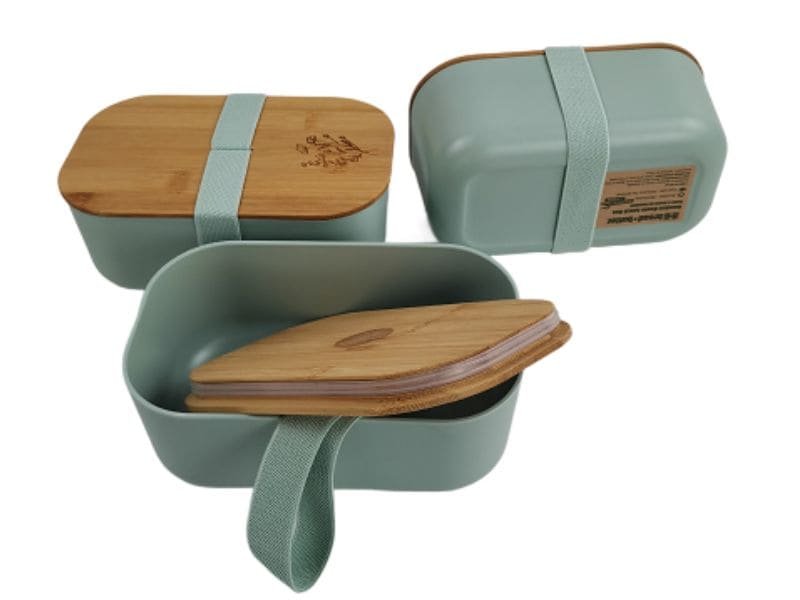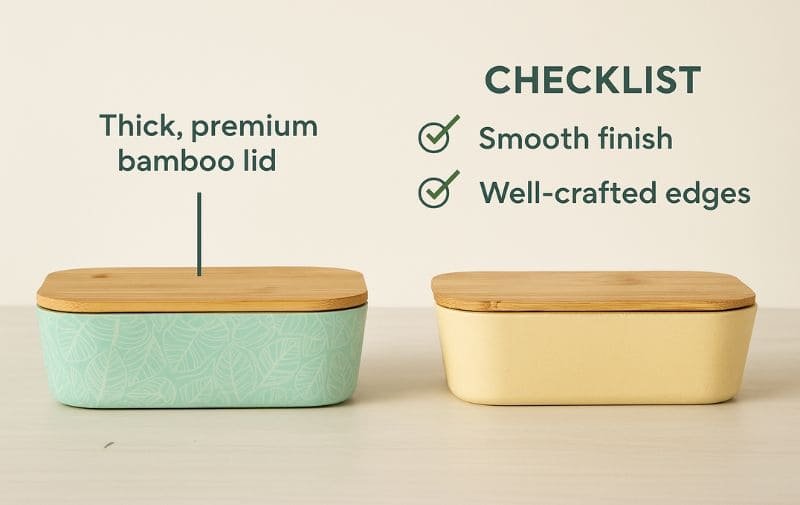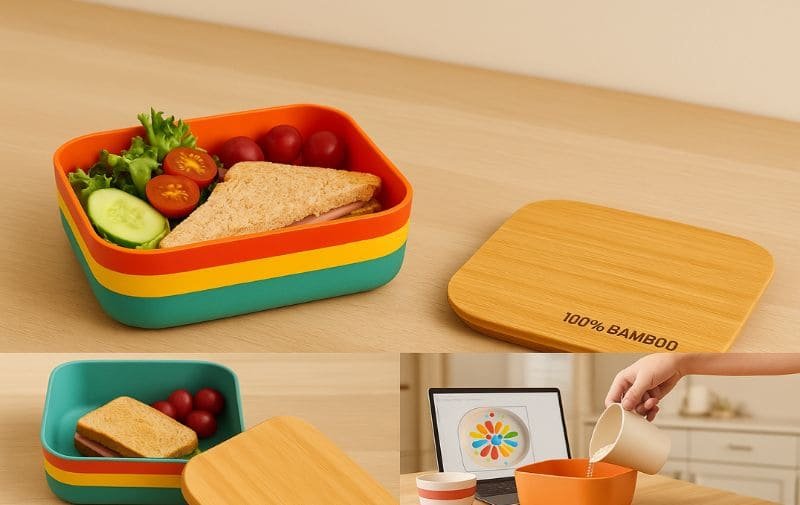Thinking about switching to a bamboo lunch box? You’re not alone! These stylish containers are popping up everywhere. But are bamboo lunch boxes safe? Can you microwave bamboo lunch boxes? And can you put fluids in a bamboo lunch box without a leaky mess? This guide for 2025 dives deep into everything you need to know about making bamboo lunch boxes (and their close cousin, the melamine lunch box) your go-to for meal prep.
Last Updated: June 7, 2025 | Estimated Reading Time: 9 Minutes
Demystifying “Bamboo”: What Are These Lunch Boxes Really Made Of?
First things first, the term “bamboo lunch box” can be a bit of a shorthand. It’s important to understand their common composition:
- The Hybrid Reality: Most lunch box bases you see marketed as “bamboo” are actually made from bamboo fiber (powdered bamboo) mixed with a food-grade binder. Very often, this binder is melamine resin (look for A5 quality from reputable brands like Duramela). This creates a material that’s durable, moldable, and easy to clean.
- Solid A5 Melamine Option: Sometimes, the base box might be made from solid A5 melamine (a high-quality, food-safe plastic) which can then be printed with various designs, sometimes even bamboo-like patterns.
- The Lid: The lid is where you might find variation. It could be:
- A 100% Bamboo Lid: Made from solid, natural bamboo wood.
- A Bamboo Fiber Composite Lid: Similar to the base.
- An A5 Melamine Lid: Matching or contrasting with the base.
Industry Insider Tip: It’s more accurate to think of many as “bamboo fiber composite lunch boxes.” Understanding this hybrid nature is key to understanding their properties, especially regarding safety and microwave use.

Safety First: Are Bamboo Lunch Boxes Safe for Your Food?
The short answer is yes, when made correctly with quality materials.
- The Key is the Binder (and Bamboo):
- If the binder used with the bamboo fiber is high-quality, food-grade melamine (like A5), and the product complies with food safety standards (e.g., FDA, FSC, LFGB, BPA-Free), then yes, it’s safe.
- The bamboo fiber itself is inert and safe for food contact.
- Past Concerns Addressed by Quality:
- Some older or cheaper “eco” products raised concerns due to lower-grade binders or unsafe levels of formaldehyde. Reputable manufacturers today ensure their bamboo-melamine composites are thoroughly tested and safe.
- Always look for clear food safety certifications from your supplier.
How do they compare to other materials?
| Feature | Bamboo Fiber Composite (with A5 Melamine binder) | Pure A5 Melamine | Traditional Plastic (e.g., Polypropylene) |
|---|---|---|---|
| Food Safety | ✅ Safe with quality binder & certs | ✅ Safe & Certified | Variable; look for BPA-free & food-grade |
| Chemical Concerns | Low with reputable brands | Very Low | Potential for BPA/phthalates in some plastics |
| Durability | Good to Very Good | Very Good | Fair to Good |
Safety Tip: Always check for certifications like FDA (USA), LFGB (Europe), and BPA-Free statements. A transparent supplier will readily provide this information. This ensures the safe lunch containers you choose truly are safe.
The Microwave Question: Can You Actually Microwave Bamboo Lunch Boxes?
This is where many get confused. Here’s the expert take:

- For the Main Container (Bamboo Fiber + Melamine Binder OR Solid A5 Melamine): Generally NO.
- While some manufacturers might claim “microwave safe for short periods” (e.g., 1-2 minutes at very low power), industry experts generally do not recommend this for long-term durability or absolute safety.
- The melamine binder (even A5 grade) is not designed for microwave heating. It can absorb microwave energy, heat unevenly, and over time, this may lead to material degradation, warping, or in extreme cases with very low-quality products, potential leaching of chemicals.
- The bamboo fibers themselves can also dry out and become brittle with repeated microwaving.
- For a 100% Bamboo Lid: A DEFINITE NO!
- Natural bamboo wood should never go in the microwave. It will dry out rapidly, crack, warp, and could even scorch or char.
- Natural bamboo wood should never go in the microwave. It will dry out rapidly, crack, warp, and could even scorch or char.
What are the potential risks if a non-microwave-safe “bamboo bento box” is heated?
- Damage to the lunch box, reducing its lifespan.
- Uneven heating of food.
- Potential for the box to become too hot to handle.
- In worst-case scenarios with poor quality items, compromising food safety.
Unique Perspective: The main appeal of these stylish bento lunch boxes lies in their eco-friendlier appearance and excellent reusability for cold or room-temperature meals, or for transferring food to a separate microwave-safe dish for heating. Don’t risk damaging your lunch box or its integrity.
Liquid Lunch? Can You Confidently Put Fluids in a Lunch Box?
So, can you put fluids like soups or dressings without it turning into a bag-catastrophe?
- Yes, with the right design! The body of a well-made bamboo-melamine composite (or solid A5 melamine) lunch box is non-porous and can hold liquids.
- The Seal is Everything: The critical factor for a leakproof bamboo lunch box is the silicone sealing ring often found in the lid. This applies whether the lid is 100% bamboo, bamboo fiber composite, or A5 melamine.
- Ensure the seal is present, correctly fitted into its groove, and clean.
- A well-designed lid will compress this seal effectively against the rim of the box base.
Industry Pain Point: Cheaper lunch boxes might skimp on the quality or design of the seal or the lid-box interface, leading to frustrating leaks. Look for a substantial, well-seated silicone ring and a lid that closes snugly and evenly. Some designs with deeper grooves for the seal might offer better liquid containment.
Understanding Your Bamboo Bento Box: Key Features and Materials
Beyond the basics, let’s look at what makes these bento boxes versatile.
Lid Choices and Customization: Bamboo, Melamine, and Branding
The lid isn’t just a cover; it’s a statement!
| Lid Type | Material | Customization Strengths | Aesthetic |
|---|---|---|---|
| 🌲 100% Bamboo Lid | Solid Natural Bamboo | Ideal for laser engraved bamboo lid (logos, names) | Natural, premium, eco-chic |
| 🎨 Printed Composite/Melamine Lid | Bamboo Fiber + Melamine OR A5 Melamine | Allows full-color printed bamboo lunch box designs | Vibrant, extensive graphics, modern |
- Both types typically incorporate a silicone seal for leak resistance.
- Purchasing Advice: Your choice depends on your desired look and branding. Pure bamboo lids offer a subtle, upscale engraved branding. Composite or melamine lids allow for bold, colorful printed statements.
Capacity & Inner Configurations: Tailoring to Your Meal
They have various sizes to suit different appetites:
- Common Capacities: 600ml, 700ml, 900ml, up to 1200ml for larger meals.
Many bento box styles also offer smart organization:
- Inner Trays: Optional removable trays (usually A5 melamine or bamboo fiber) are fantastic for separating different food items – think a main dish and a side, or keeping wet and dry ingredients apart.
- Included Cutlery: Some models come with a matching spoon and fork (often melamine or bamboo fiber), enhancing their grab-and-go convenience.
Colors and Prints
You can often find them in plain, solid colors (where the bamboo fiber composite base is colored) or with custom prints applied to the base or the lid (if it’s not a 100% bamboo lid).
Caring for Your Bamboo Lunch Box: Tips for Longevity
With a little care, your stylish lunch companion can last for years.

- Cleaning the Box
- Generally dishwasher safe.
- Top rack is recommended to avoid direct, intense heat from the dishwasher’s heating element, which can prolong its life.
- Cleaning a 100% Bamboo Lid:
- HAND WASH ONLY. Never put a solid bamboo lid in the dishwasher. The heat and harsh detergents will cause it to warp, crack, or split.
- Use mild soap and water.
- Dry thoroughly with a cloth immediately after washing. Don’t let it air dry if you can help it, as prolonged moisture isn’t ideal for natural wood.
- Common Mistakes to Avoid:
- Microwaving: As discussed, avoid it!
- Dropping: While durable, bamboo fiber/melamine can crack or chip if dropped hard on a hard surface.
- Abrasive Cleaners/Scourers: Can scratch the surface.
- Soaking a 100% Bamboo Lid: Can lead to swelling or cracking.
Bamboo vs. Other Options: Why Choose a Bamboo or Melamine Lunch Box?
How do bamboo lunch boxes and melamine lunch boxes stack up against traditional choices?
| Feature | Bamboo Fiber / A5 Melamine | Glass | Stainless Steel |
|---|---|---|---|
| Weight | Lightweight | Heavy 🏋️♀️ | Medium ⚖️ |
| Durability | Good (can chip/crack if dropped hard) | Fair (can break/shatter) | Very High (can dent) |
| Microwave Safe? | Generally No 🚫 | Yes (container, not some lids) ✅ | No 🚫 |
| Eco-Friendliness | Better (renewable bamboo component, reusable) 🌿 | Good (recyclable, long life) | Good (recyclable, long life) |
| Cost (General) | Moderate $$ | Moderate $$ | Moderate to High $$$ |
| Leak-Proofing | Good (with quality seal) | Good (with quality seal) | Excellent (often screw-top) |
The “Eco” Factor: A Balanced View
- Pros: Bamboo is a fast-growing, renewable resource, making the bamboo fiber component a more sustainable choice than purely fossil fuel-based plastics. The main eco-benefit is their reusability, displacing countless single-use containers.
- Considerations: The melamine binder is a type of plastic. So, while “more sustainable” overall, they are not typically 100% biodegradable unless a specific, less common biodegradable binder is used (which would have different properties and care instructions).
Why is a “bamboo bento box” a popular choice? The compartmentalized nature of bamboo bento lunch box designs, often with inner trays, makes them perfect for portion control and keeping different elements of your meal beautifully organized and separate until you’re ready to eat.
Thermal Properties: Keep in mind that bamboo lunch boxes (much like standard A5 melamine or plastic ones) are not insulated. Hot foods will cool, and cold foods will warm up over a few hours. They are best for meals eaten relatively soon or if you have access to a refrigerator.
Sourcing Smart: What to Look For in a Quality Lunch Box
To ensure you get a safe, durable, and reliable product:
- Seek Certifications: Ask your supplier for food safety certifications like FDA, LFGB, and BPA-Free confirmation.
- Demand Material Transparency: Understand exactly what the box and lid are made of (e.g., “bamboo fiber with A5 melamine binder,” “100% bamboo lid“).
- Inspect Seal Quality: If buying in person, check the silicone seal. For online purchases, rely on reputable brands known for quality.
- Be Wary of Vague Claims: Question unsupported statements like “100% biodegradable” (if a melamine binder is used) or “fully microwave safe” unless clearly backed by specific testing and material information.
So, Is a Bamboo Lunch Box Right for You?
Considering safety, microwave (non)-use, and liquid containment, here’s the verdict:

It’s an excellent choice if you:
- Prioritize a stylish, modern aesthetic for your meals.
- Are looking for a reusable, eco-friendly lunch box alternative to single-use plastics.
- Primarily pack cold or room-temperature meals, or plan to transfer food to another dish for heating.
- Appreciate organized meal components.
- Are careful with your belongings and understand the hand-washing needs of a bamboo lid.
They might not be the best fit if you:
- Absolutely need to microwave your lunch directly in its container.
- Are prone to frequently dropping your lunch box.
- Require a fully insulated container for temperature control over many hours.
For those seeking a durable, safe, and often customizable option, a high-quality bento box offers a great blend of practicality and style.
FAQ: Your Bamboo Lunch Box Questions Answered
Q1: Are bamboo lunch boxes completely biodegradable?
If made with a standard melamine binder, no, they are not fully biodegradable. The bamboo fiber part is, but the resin is not. Their main eco-benefit comes from reusability and the use of renewable bamboo. Some niche products might use plant-based biodegradable binders, but these are less common and have different properties.
Q2: Can I put my bamboo lunch box in the freezer? Generally, yes. Bamboo fiber composite and A5 melamine are usually freezer-safe. However, like with any container, leave some headspace if freezing liquids to allow for expansion. Avoid thermal shock (e.g., moving directly from freezer to very hot water).
Q3: How do I get rid of food stains or smells from my bamboo lunch box?
For stains, a paste of baking soda and water can be effective. For smells, washing thoroughly and then airing it out (with the lid off) usually works. For persistent smells, you can try wiping the inside with a dilute vinegar solution, then washing and rinsing well.
Q4: Is a “bamboo fiber lunch box” the same as a “melamine lunch box”?
Not exactly. A “bamboo fiber lunch box” specifically contains bamboo fiber mixed with a binder (often melamine). A “melamine lunch box” is typically made of solid A5 melamine resin. Both are durable and food-safe when made to proper standards, but the bamboo fiber version has a different aesthetic and eco-story.
Q5: What is an “engraved bamboo lid” good for?
An engraved bamboo lid offers a sophisticated way to personalize or brand a lunch box. Laser engraving creates a permanent, subtle design, often used for logos, names, or simple artwork on the 100% bamboo lid.
Conclusion: Your Stylish and Conscious Lunch Companion
Bamboo lunch boxes offer a compelling mix of style, reusability, and when sourced carefully, food safety. While they’re not your go-to for microwave heating, their strengths in carrying room-temperature or cold meals, their organizational bento features, and their reduced reliance on virgin plastics make them a smart choice for the eco-conscious and fashion-forward meal prepper.
By understanding their true composition and care needs, you can enjoy your delicious and well-packed meals to come!
Recommended Links:
Explore the Range of Bamboo and Melamine Lunch Boxes



